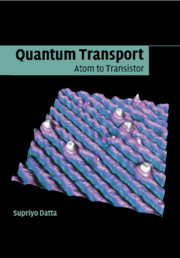Book contents
- Frontmatter
- Contents
- Preface
- Acknowledgements
- List of symbols
- 1 Prologue: an atomistic view of electrical resistance
- 2 Schrödinger equation
- 3 Self-consistent field
- 4 Basis functions
- 5 Bandstructure
- 6 Subbands
- 7 Capacitance
- 8 Level broadening
- 9 Coherent transport
- 10 Non-coherent transport
- 11 Atom to transistor
- 12 Epilogue
- Appendix: advanced formalism
- MATLAB codes used to generate text figures
- Further reading
- References
- Index
11 - Atom to transistor
Published online by Cambridge University Press: 05 June 2012
- Frontmatter
- Contents
- Preface
- Acknowledgements
- List of symbols
- 1 Prologue: an atomistic view of electrical resistance
- 2 Schrödinger equation
- 3 Self-consistent field
- 4 Basis functions
- 5 Bandstructure
- 6 Subbands
- 7 Capacitance
- 8 Level broadening
- 9 Coherent transport
- 10 Non-coherent transport
- 11 Atom to transistor
- 12 Epilogue
- Appendix: advanced formalism
- MATLAB codes used to generate text figures
- Further reading
- References
- Index
Summary
In Chapter 1, I used the generic structure shown in Fig. 11.1.1a (see Section 11.1.1) to focus and motivate this book. We spent Chapters 2 through 7 understanding how to write down a Hamiltonian matrix [H0] for the active region of the transistor structure whose eigenvalues describe the allowed energy levels (see Fig. 11.1.1b). In Chapter 8, I introduced the broadening [Г1] and [Г2] arising from the connection to the source and drain contacts. In Chapter 9, I introduced the concepts needed to model the flow of electrons, neglecting phase-breaking processes. In Chapter 10 we discussed the nature and meaning of phase-breaking processes, and how the resulting inflow and outflow of electrons is incorporated into a transport model. We now have the full “machinery” needed to describe dissipative quantum transport within the self-consistent field model (discussed in Chapter 3) which treats each electron as an independent particle moving in an average potential U due to the other electrons. I should mention, however, that this independent electron model misses what are referred to as “strong correlation effects” (see Section 1.5) which are still poorly understood. To what extent such effects can be incorporated into this model remains to be explored (see Appendix, Section A.5).
My purpose in this chapter is to summarize the machinery we have developed (Section 11.1) and illustrate how it is applied to concrete problems. I believe these examples will be useful as a starting point for readers who wish to use it to solve other problems of their own.
- Type
- Chapter
- Information
- Quantum TransportAtom to Transistor, pp. 285 - 311Publisher: Cambridge University PressPrint publication year: 2005
- 10
- Cited by

